I love stop motion. It’s the only thing I can think of that brings together all the things I’m passionate about, all in one place. Design, writing, carpentry, puppet-making, animation, poetry, photography, music, and… painting. However, I now have a love/hate relationship with painting. Way back in the 90s I studied figurative painting for 4 years before finding motion design by accident, or more specifically, being called into broadcast design in my last year of college and saying yes. So there’s always been a mild remorse at the thought of a lost career as an artist. But these are just thoughts, and they don’t mean much…
Anyway, let’s just say I began this painting having mixed feelings. Opening up that old paintbox (above) is scary for me. But I really wanted to feature a painting of a Galician landscape in this part of the set. The landscape goes into a 3-panel frame, which makes a room divider screen that separates the dining room from the kitchen. I have a particular painting style that I like, (I like GRIDS, and TRANSLUCENCY!) so I had no choice but to paint it myself. Here are the progress shots:
My reference pic, found on the web and printed out. I was specifically looking for some farmland. A cabbage patch in the Galician countryside, perhaps?
My technique for these types of paintings involves gridding out a source photo, and first roughing the image in on a similar grid on rice paper (coated with acrylic gloss medium).
Once the image is roughed in, leaving some areas translucent, I go square by square and paint one square at a time, as if each little square were an abstract painting. I am selective about the squares I want to focus on: in this case I just do the town in the BG of the scene.
Here’s the final screen, lit from front and back. I had gessoed the middle area where the cityscape is, to make this part opaque, while the field and sky are both translucent. It’ll be interesting to see this lit properly on the set.
Here’s what the screen looks like from the back. It’s kinda interesting to me to paint this way, because it’s a 3-dimensional object rather than flat. You can do the underpainting after you do the main painting. So here I added the grid to the back, as well as some turquoise and teal underpainting highlights, and backed it with the gesso, in selective spots.
Here’s a kinda rough shot of what it’ll look like in the set. The colour palette works with the dining room, and overall I’m really happy with it! Though again, it should be lit so that the sky is more glowy. But that’ll come.
If you’re interested, here’s a blast from the past — old paintings and artwork from college days… I think you can see the similarity. I have made many more grid paintings since, but these are some of my favourites.
The above two were painted from life in a portraiture class (I think), using acrylic on rice paper.
This is a combo of a portrait (photo) from me at age 4 or 5, and some accounting spreadsheets in behind… if you’re ever looking for me on facebook, this is my profile picture 😛
And this image is from an old family snapshot of my great uncle as a kid… I don’t know what the story is behind this, but always liked the photo. Just to test my patience, or perhaps prepare myself for the life of a stop motion animator, I gridded the image and mapped it out so it could be woven with seed beads. There are hundreds of thousands of seed beads colouring this image… it took close to a year to complete. The final image size is about 3 feet by 2 feet or so.

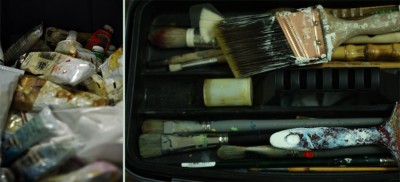


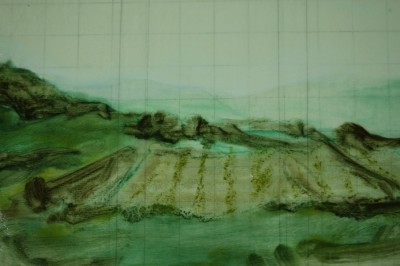

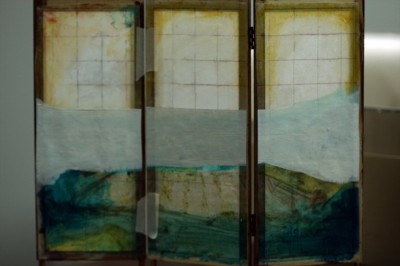


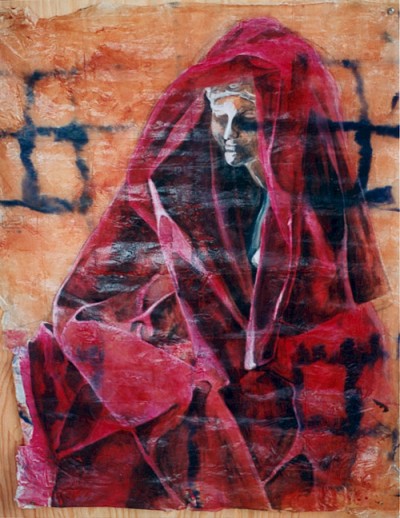
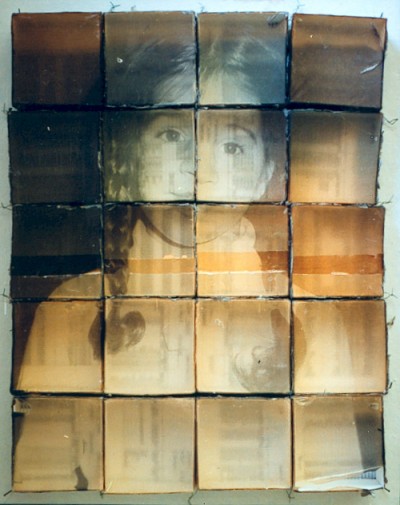


This is beautiful work, Stephanie. The screen is perfect for the setting and your themes. I learned from this post about coating rice paper, what a great solution. I bet it gives an oil-like finish.
I also love the translucency and the way the layers are interacting. It’s an endlessly fascinating subject to me.
Oh, god, and can I relate to the seed bead piece. I was on a brief seed bead micro-mosaic kick a few years ago. Each pixel that would at scale be tile was a single seed bead. Using beeswax for grout.
Oh, that mosaic sounds beautiful, but oh, so time consuming. I enjoyed making that bead piece, but I can’t say I want to do another one!
The painting for the screen is painted with oils; just the underpainting and base coats were acrylic. Seems to work well; it just took a while to dry. But I much prefer using oils for this type of work… they’re just so buttery! 🙂
That screen looks great! Why am I not surprised at your ability to paint in addition to everything else? Not that I’m the jealous type (damn you)…
seriously, woven with hundreds of thousands of seed beads?? that’s crazy! and very cool!
Great screen!!